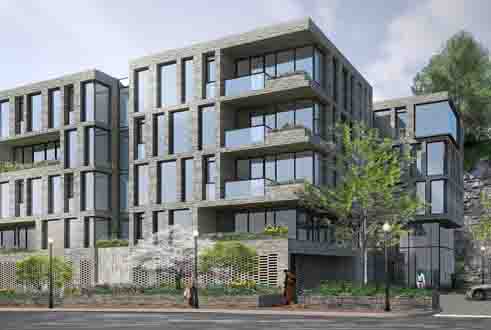Board Calls for Tweaking Exxon Condo Plans

By Brady HoltCurrent Staff Writer
A plan for condos at the site of the Key Bridge Exxon station is moving closer to fruition, but the Old Georgetown Board continues to seek architectural refinements.
EastBanc is proposing 26 to 28 luxury condo units in a five-story, 50-foot-tall building at 3601-3607 M St., in a project dubbed “Hillside.” The board had previously signed off on the size of the building despite community objections, but members requested revisions to architectural details.
The board — part of the U.S. Commission of Fine Arts — reviewed the company’s latest designs last Thursday. “The preferred scheme that was presented last week was a move in the right direction,” but members felt it still needs some tweaks, commission secretary Tom Luebke said in an interview.
At that Thursday meeting, the board also informally supported rough plans for an addition at Hyde-Addison Elementary School and requested a revised design for a mixed-use project proposed at 3000 M St., according to Luebke.
On the Exxon project, Luebke said the board suggested revising the first floor to make the upper levels look less like they’re “floating,” as well as additional vertical design elements. “It feels like it’s an office building or an embassy, and it needs to feel more residential,” he said.
The board also asked EastBanc to reduce the height of its rooftop mechanical equipment so that it will have less impact on the Prospect Street homes that overlook the M Street property. Residents there, and the Georgetown advisory neighborhood commission, had unsuccessfully petitioned the board to allow only a 40-foot building.
EastBanc’s Mary Mottershead wrote in an email to The Current that the company doesn’t mind revising its architecture. “Design is subjective, and OGB always has good comments,” she wrote. “Right now we don’t really see any downsides per se to the direction from OGB as long as we and they continue to narrow down the search for an acceptable design.”
However, revising the roof structures would force EastBanc to seek a variance from the Board of Zoning Adjustment — a three- to six-month process that Mottershead said could affect the project’s timeline. The company has said previously it hopes to break ground in spring 2015, with construction lasting 20 to 22 months.
In addition to sightlines, Prospect Street residents have also raised concerns about the project’s impact on the retaining wall that holds their homes in place. The Georgetown advisory neighborhood commission has urged EastBanc to pay attention to this issue.
On Hyde-Addison Elementary, Luebke said the board was comfortable with the idea of a new building at the center of the school property. The feedback will let project architects fully refine this approach and return to the board for further approvals, Luebke said.
The addition proposed is a three-story, 25,000-square-foot structure — connecting to the existing school buildings via hallways — with the bottom level below grade, comprising a gym, cafeteria, media center and classroom space. D.C. Public Schools officials cited the expansion as a reason to enlarge the boundaries for Hyde-Addison as part of a newly released city plan aimed at relieving crowding at nearby schools.
Construction of an addition at the 3219 O St. school was slated to begin this summer, but faced delays after the Old Georgetown Board rejected a previous proposal that would have buried the new space under the school’s playground.
At 3000 M St., the site of the closed Latham Hotel and vacant retail space, developer SB-Urban hopes to construct new storefronts and turn the hotel building into about 150 “micro” apartment units with shared amenity space. Luebke said the board supported the general idea but had concerns about the style and scale of some of the plans.
In particular, the board said the proposed second story of retail was too tall and “top-heavy,” according to Luebke. “It’s putting two stories in an area that’s usually three or four,” he said.
The board also criticized an M Street “tower” structure and the 30th Street “arcade” entrance, both of which are dominated by glass in the SB-Urban plans. And according to Luebke, board members also said the company should consider “a more bold reworking” of the staid brick hotel building, which is mostly untouched in the SB-Urban proposal above the ground level.
Board members did support the proposal to demolish and replace the M Street retail space, even though they were not comfortable with SB-Urban’s specific designs for it, Luebke added.
This article appears in the April 9 issue of The Georgetown Current newspaper.
